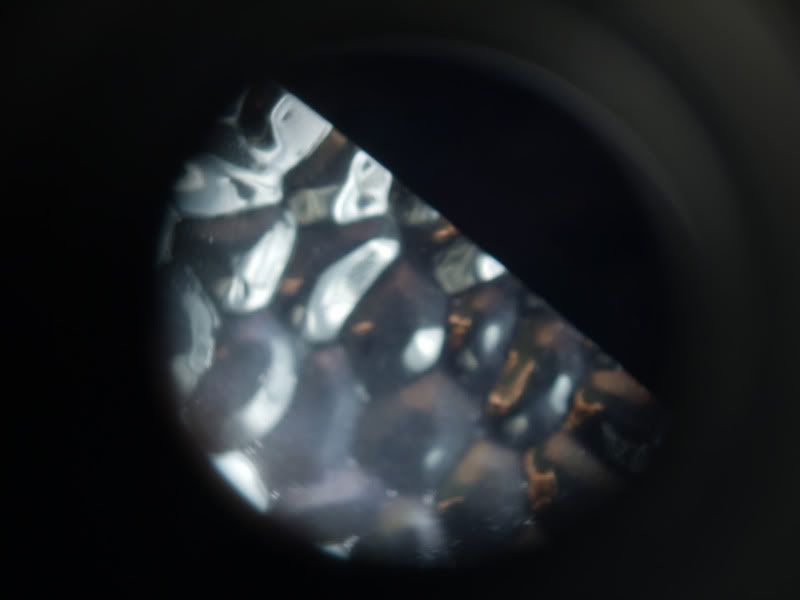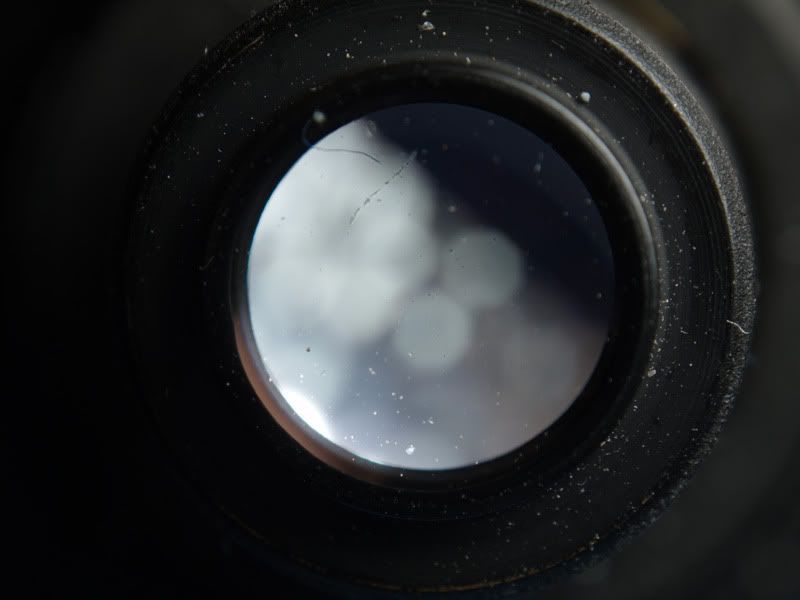ChrisR wrote:There must be standard ways. [to find the entrance pupil]
Sure. Set up another lens system to look into the front of the objective and focus on the edge of the limiting aperture. Wherever the focus point of the other lens system is, that's where the entrance pupil of the objective is.
I just ran through this exercise with three of my objectives, using two "other lens systems": 1) my naked eyeball augmented by a 10X loupe, and 2) a compact digital point-and-shoot. One objective at 10X NA 0.25 does have its entrance pupil essentially at infinity (so I am a little surprised, as promised). My Nikon CF N Plan Achro 10X NA 0.30 has its entrance pupil 5 cm or so in front of the objective (on the back side of the in-focus subject); and my CF ELWD 20X NA 0.40 has its entrance pupil a couple of cm in front of the objective, again on the back side of the subject.
But with all three of these objectives, at least in a quick test, the scale change within the in-focus slab was too small to worry about (no visible smearing) and also too small for Zerene Stacker to measure accurately. Turning off scale correction would be safe and effective.
I guess I can imagine cases where it would be important to know the pupil location, but I don't anticipate doing any work nearly that precise.
Would this work: a 1mm hole drilled into (Cyan) perspex, with razor-saw slits at 1mm increments along the hole, from the sides.
Focus with the rear standard (=sensor)
Take the pic, stack with scaling off, do the trig, average the errors,...
?
This won't work as well as it might appear.
As background, remember that what the entrance pupil position controls is perspective, which really amounts to how scale changes with distance.
It's easy to determine entrance pupil location if we can clearly see objects at two significantly different distances without changing focus. In that case, any change in scale is due entirely to perspective caused by the entrance pupil location.
If we have to refocus to clearly see objects, the problem gets a lot worse. Any scale changes then are due partly to refocusing and partly to perspective. To determine perspective, we have to back out any scale changes due to refocusing, and then work with what's left.
In the scheme shown above, if we do not back out the scale change caused by refocusing, then what we'll get is a strongly converging pattern regardless of where the entrance pupil is.
The scheme can be adapted to work, in theory, by explicitly rescaling images to take into account the change in magnification caused by changing the lens-to-sensor distance. Whatever change in scale is left after that must be due to entrance pupil location.
But...
(there's always a "but")...in order for this to work, we have to know very precisely how much change in magnification is due to changing the lens-to-sensor distance. If we get that wrong, then we'll be calculating entrance pupil location from what is actually residual error in the rescaling.
OK, no problem
(it seems), let's just
measure the change in magnification as we change focus, say by shooting an image of an in-focus scale micrometer. The problem with this approach is that when we back out those particular measurements, we end up making the image of the micrometer the same size at all focus distances. That results in apparently no change in magnification with distance, the hallmark of a telecentric lens. We have computed the entrance pupil to be at infinity as a result of the way we made the measurement.
The underlying difficulty with any approach involving just the imagery is that we're trying to determine entrance pupil location by observing what lines up with what. Because of the shallow DOF, we can only tell what is lined up within a very thin slab, where the scale changes are too small to measure accurately. Think about trying to make a distance measurement by triangulation using a baseline that's way too short -- any small error in the angles gets multiplied by a long lever arm and turns into a big error in distance to target. In the same way, when DOF is very shallow, any small error in the observations turns into large error in estimating the entrance pupil location from imagery.
--Rik






